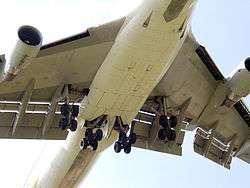Krueger flap

Krueger flaps are lift enhancement devices that may be fitted to the leading edge of an aircraft wing. Unlike slats or drooped leading edges, the main wing upper surface and its nose is not changed. Instead, a portion of the lower wing is rotated out in front of the main wing leading edge. Current Boeing aircraft, and many others, use this design between the fuselage and closest engine, where the wing is thickest. Outboard of the engine, slat flaps are used on the leading edge. The Boeing 727 also used a mix of inboard Krueger flaps and outboard slats, although it had no engine between them. Most early jet airliners, such as the Boeing 707 and Boeing 747, used Krueger flaps only.
Operation
While the aerodynamic effect of Krueger flaps may be similar to that of slats or slots (in those cases where there is a gap or slot between the flap trailing edge and wing leading edge), they are deployed differently. Krueger flaps, hinged at their foremost position that once deployed actually become their trailing edges, hinge forwards from the under surface of the wing, increasing the wing camber and maximum coefficient of lift.[1] Conversely, slats extend forwards from the upper surface of the leading edge. Also, when deployed, Krueger flaps result in a much more pronounced blunt leading edge on the wing, helping to achieve better low-speed handling. This allows smaller-radius wing leading edges, better optimized for cruise.
The Krueger flaps developed for the Boeing 747 were constructed from fiberglass honeycomb material and were designed to be intentionally distorted into an aerofoil section on deployment.[2]
History
Krüger flaps were invented by Werner Krüger in 1943 and evaluated in the wind tunnels in Göttingen, Germany.[3] One of the earliest applications was the Boeing 707 in 1954. The flap was added to prevent wing stall with an extreme attitude take-off with the tail dragging on the runway, a scenario that had already caused two deHavilland Comet accidents. A preliminary flight test had been made on the Boeing 367-80 using a fixed flap and a skid on the after-body.[4]
 Krueger flap operation
Krueger flap operation Slat operation
Slat operation
Boeing commenced a series of test flights on 17 March 2015 with a modified Boeing 757, incorporating new wing-leading-edge sections and an actively blown vertical tail.[5] The left wing has been modified to include a 6.7 m-span glove section supporting a variable-camber Krueger flap which will be deployed during landing and which protrudes just ahead of the leading edge. Although Krueger flaps have been tried before as insect-mitigation screens, previous designs caused additional drag; the newer design being tested is variable-camber and designed to retract as seamlessly as possible into the lower wing surface. Increasing the use of natural laminar flow (NLF) on an aircraft wing has the potential to improve fuel burn by as much as 15%, but even small contaminants from insect remains will trip the flow from laminar to turbulent, destroying the performance benefit. The test flights have been supported by the European airline group TUI AG and conducted jointly with NASA as part of the agency’s Environmentally Responsible Aviation (ERA) program.
See also
References
| Wikimedia Commons has media related to Krueger flaps. |
Notes
- ↑ Gary V. Bristow (2002). Ace the Technical Pilot Interview. McGraw-Hill Professional. ISBN 0-07-139609-8. Retrieved 2009-02-16.
- ↑ Taylor 1990, p. 114.
- ↑ Niels Klußmann; Arnim Malik (2012). Lexikon Der Luftfahrt. Springer. pp. 193–. ISBN 978-3-642-22500-0.
- ↑ "The Road to the 707" Cook, William H., TYC Publishing Company, Bellevue, 1991, ISBN 0-9629605-0-0, p.249
- ↑ "'757 EcoDemo Focuses On Laminar And Active Flow'". Aviation Week. 23 March 2015. Retrieved 23 March 2015.
Bibliography
- Taylor, John W.R. The Lore of Flight, London: Universal Books Ltd., 1990. ISBN 0-9509620-1-5.